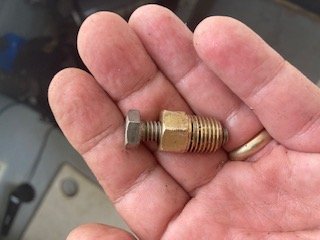Dougcole
Guru
Hi All,
Full disclosure, this is not my idea, I learned from a TF member about ten years ago, but I thought I would pass it on as some may not have seen it and it is so useful.
There is not much clearance above the pencil zinc on the heat exchanger on my Kohler generator, which makes getting to the zinc a bit of an issue. I usually get the zinc out ok, but occasionally the cap unscrews and leaves the zinc itself stuck in the hole. No problem on my main engines, I just tap it through, but on the genset there is no room to do that. I have about two inches between the zinc hole and the bottom of the water pump. Usually when this happens there is not enough of the zinc left to pull it out from inside the HE. The stuck piece of zinc prevents the installation of a new zinc, so it's an issue. The only other way I can think of to get it out is to remove the entire HE (oh boy).
So I made this little bugger. You just screw in the cap, then tighten the bolt. It pushes the piece of zinc through into the HE. I don't have to use it often, but when I do it's a life saver.
It's easy to make, easier if you have a drill press. Hope this helps somebody.
Full disclosure, this is not my idea, I learned from a TF member about ten years ago, but I thought I would pass it on as some may not have seen it and it is so useful.
There is not much clearance above the pencil zinc on the heat exchanger on my Kohler generator, which makes getting to the zinc a bit of an issue. I usually get the zinc out ok, but occasionally the cap unscrews and leaves the zinc itself stuck in the hole. No problem on my main engines, I just tap it through, but on the genset there is no room to do that. I have about two inches between the zinc hole and the bottom of the water pump. Usually when this happens there is not enough of the zinc left to pull it out from inside the HE. The stuck piece of zinc prevents the installation of a new zinc, so it's an issue. The only other way I can think of to get it out is to remove the entire HE (oh boy).
So I made this little bugger. You just screw in the cap, then tighten the bolt. It pushes the piece of zinc through into the HE. I don't have to use it often, but when I do it's a life saver.
It's easy to make, easier if you have a drill press. Hope this helps somebody.



